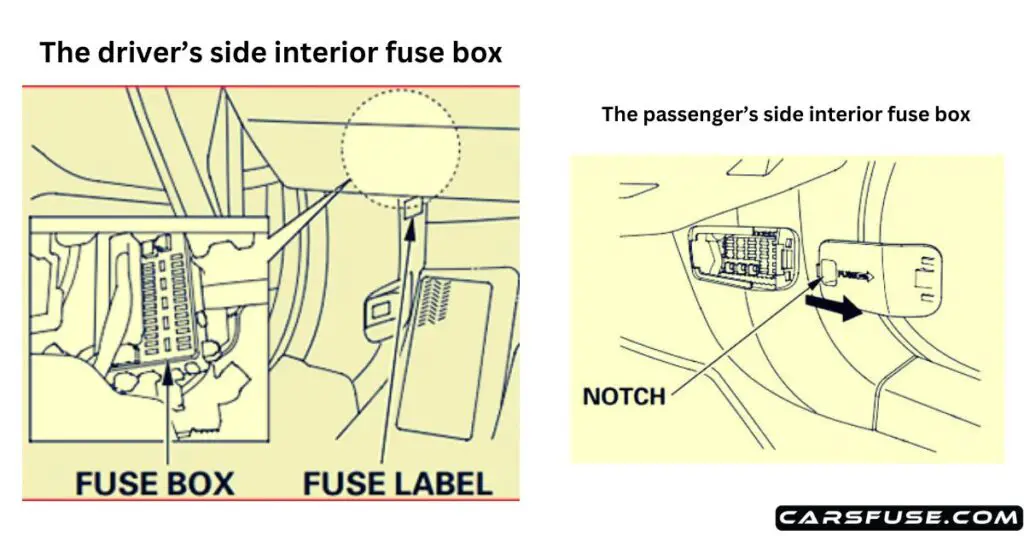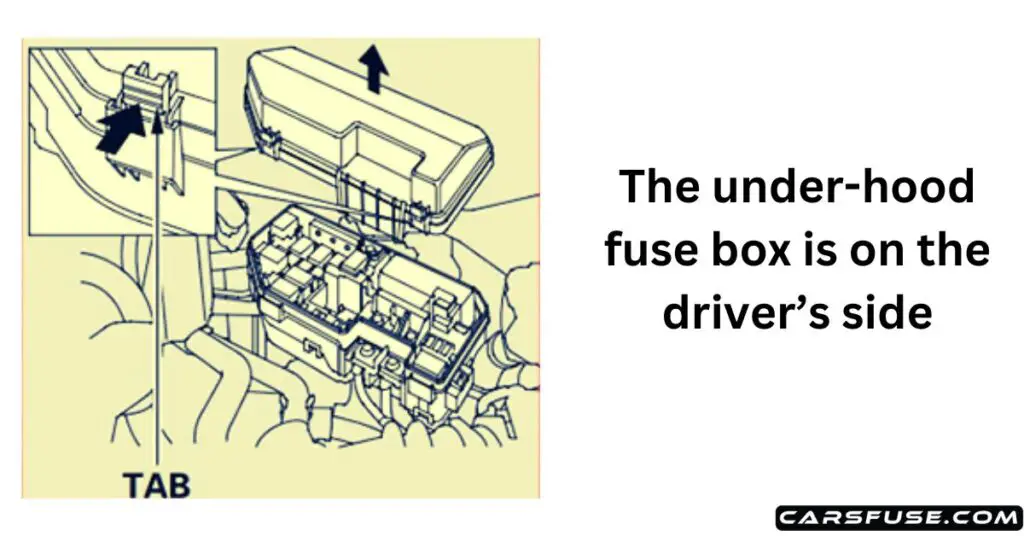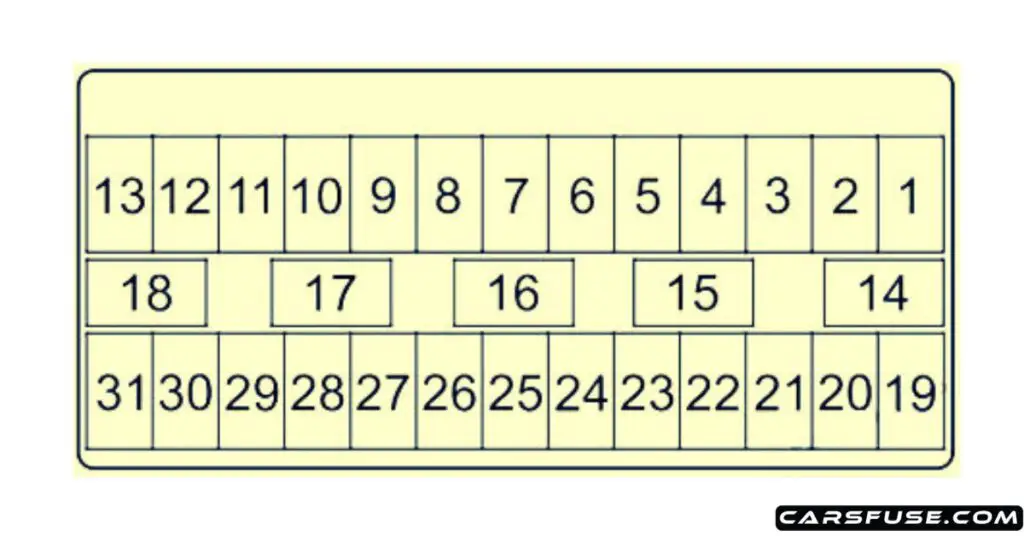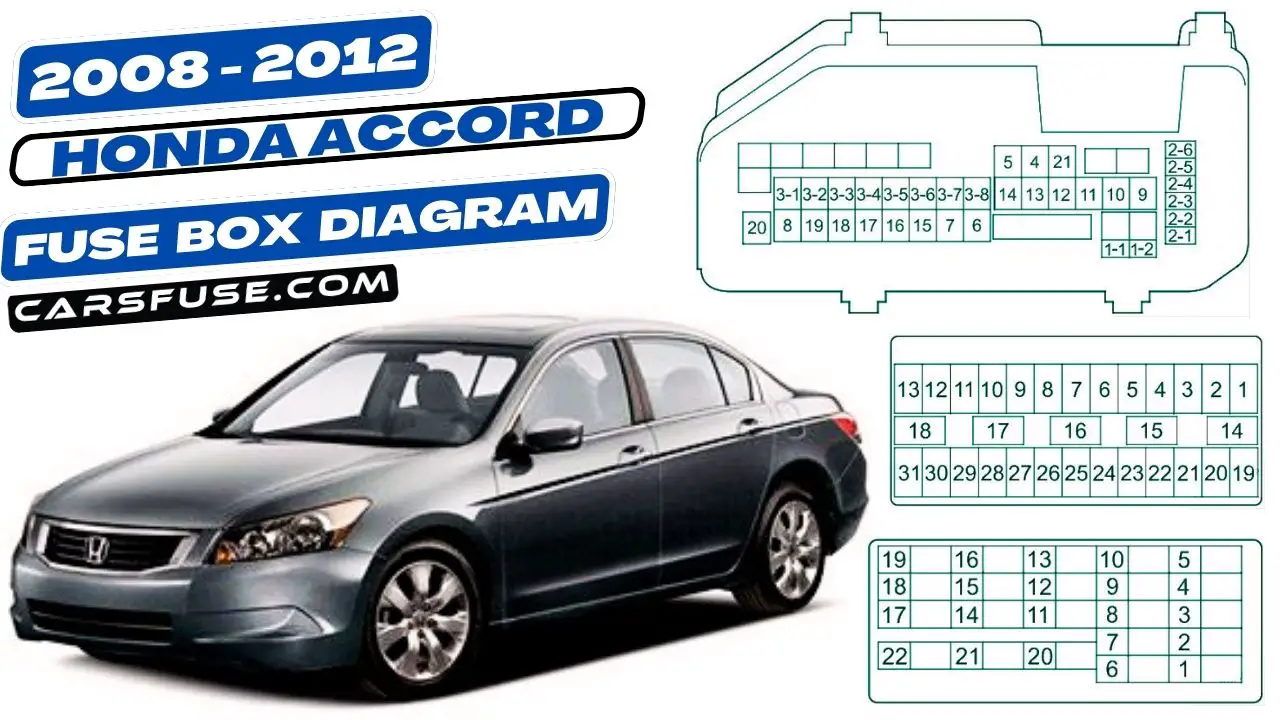The Honda Accord is a popular midsize sedan that has been in production since 1976. The 2008-2012 Accord models have two fuse boxes: one under the hood, and one on the passenger’s side of the dashboard.
Table of Contents


Engine Compartment

| Fuse Number | Amp. Rating | Protected Components |
|---|---|---|
| 1-1 | 100 A | Battery (4-cylinder models) |
| 1-1 | 120 A | Battery (V6 models) |
| 1-2 | 40 A | Passenger’s Side Fuse Box |
| 2-1 | — | Not Used |
| 2-2 | 40 A | ABS/VSA |
| 2-3 | 30 A | ABS/VSA Motor |
| 2-4 | (40 A) | Passenger’s Side Fuse Box |
| 2-5 | — | Not Used |
| 2-6 | — | Not Used |
| 3-1 | — | Not Used (4-cylinder models) |
| 3-1 | 30 A | Sub Fan Motor (V6 models) |
| 3-2 | 30 A | Wiper Motor |
| 3-3 | 30 A | Main Fan Motor |
| 3-4 | 30 A | Driver’s Side Light Main |
| 3-5 | (60 A) | Driver’s Side Fuse Box |
| 3-6 | 30 A | Passenger’s Side Light Main |
| 3-7 | (40 A) | Driver’s Side Fuse Box |
| 3-8 | 50 A | IG Main |
| 4 | 40 A | Rear Defroster |
| 5 | 20 A | Sub Fan Motor (4-cylinder models) |
| 5 | — | Not Used (V6 models) |
| 6 | — | Not Used |
| 7 | — | Not Used |
| 8 | 40 A | Heater Motor |
| 9 | 15 A | Hazard |
| 10 | 20 A | Horn, Stop |
| 11 | — | Not Used |
| 12 | — | Not Used |
| 13 | 15 A | IG Coil |
| 14 | 15 A | FI Sub |
| 15 | 10 A | Back Up |
| 16 | 7.5 A | Interior Lights |
| 17 | 15 A | FI Main |
| 18 | 15 A | DBW |
| 19 | — | Not Used (4-cylinder models) |
| 19 | 7.5 A | Back Up, FI ECU (V6 models) |
| 20 | 7.5 A | MG Clutch |
| 21 | 7.5 A | Fan Relay |
Passenger Compartment
[Driver’s Side]

| Fuse Number | Fuse Amp. Rating | Protected Components |
|---|---|---|
| 1 | — | Not Used |
| 2 | 7.5 A | Seat Memory (If equipped) |
| 3 | 15 A | Washer |
| 4 | 7.5 A | Wiper |
| 5 | 7.5 A | Meter |
| 6 | 7.5 A | ABS/VSA |
| 7 | 15 A | ACG |
| 8 | 7.5 A | STS (If equipped) |
| 9 | 20 A | Fuel Pump |
| 10 | 10 A | VB SOL (If equipped) |
| 11 | 10 A | SRS |
| 12 | 7.5 A | ODS (Occupant Detection System) |
| 13 | — | Not Used |
| 14 | 10 A | ACM (If equipped) |
| 15 | 7.5 A | Daytime Running Lights |
| 16 | 7.5 A | A/C |
| 17 | 7.5 A | Accessory, Key, Lock |
| 18 | 7.5 A | Accessory |
| 19 | 20 A | Driver’s Power Seat Sliding (If equipped) |
| 20 | 20 A | Moonroof (If equipped) |
| 21 | 20 A | Driver’s Power Seat Reclining (If equipped) |
| 22 | 20 A | Rear Left Power Window |
| 23 | 15 A | Front Accessory Power Socket |
| 24 | 20 A | Driver’s Power Window |
| 25 | 10 A | Driver’s Side Door Lock |
| 26 | 10 A | Left Front Fog Light (If equipped) |
| 27 | 10 A | Left Side Small Lights (Exterior) |
| 28 | 10 A | Left Headlight High Beam |
| 29 | 7.5 A | TPMS |
| 30 | 10 A | Left Headlight Low Beam |
| 31 | — | Not Used |
[Passenger’s Side]

| Fuse Number | Fuse Amp. Rating | Protected Components |
|---|---|---|
| 1 | 10 A | Right Headlight High Beam |
| 2 | 10 A | Right Side Small Lights (Exterior) |
| 3 | 10 A | Right Front Fog Light (If equipped) |
| 4 | 10 A | Right Headlight Low Beam |
| 5 | — | Not Used |
| 6 | 7.5 A | Interior Lights |
| 7 | — | Not Used |
| 8 | 20 A | Front Passenger’s Power Seat Reclining (If equipped) |
| 9 | 20 A | Front Passenger’s Power Seat Sliding(If equipped) |
| 10 | 10 A | Right Side Door Lock |
| 11 | 20 A | Rear Right Power Window |
| 12 | 15 A | Rear Accessory Power Socket |
| 13 | 20 A | Front Passenger’s Power Window |
| 14 | — | Not Used |
| 15 | 20 A | Premium AMP(If equipped) |
| 16 | — | Not Used |
| 17 | — | Not Used |
| 18 | 10 A | Lumbar Support (If equipped) |
| 19 | 15 A | Seat Heater(If equipped) |
| 20 | — | Not Used |
| 21 | — | Not Used |
| 22 | — | Not Used |
Cigar lighter (power outlet) fuses in the Honda Accord are the fuse #23 (Front Accessory Power Socket) in the Instrument panel fuse box on the driver’s side, and fuse #12 (Rear Accessory Power Socket) in the Instrument panel fuse box on the passenger’s side.
Conclusion
If an electrical component in your Accord is not working, it may be due to a blown fuse. To check a fuse, you will need a fuse tester. A fuse tester is a small device that plugs into the fuse socket and lights up if the fuse is good.
If the fuse tester lights up, the fuse is good and the problem is with the electrical component. If the fuse tester does not light up, the fuse is blown and you will need to replace it.
Fuses are relatively inexpensive and easy to replace. To replace a fuse, first locate the fuse box diagram for your Accord. Then, locate the blown fuse and remove it from the fuse socket.
To insert the new fuse, make sure that the amperage rating of the new fuse is the same as the amperage rating of the old fuse. Then, push the new fuse into the fuse socket until it clicks into place.
By understanding the location and function of the fuse boxes in your Honda Accord, you can easily troubleshoot electrical problems and replace blown fuses.
Next Post: 2003-2009 Renault Megane II Fuse Box Diagram
Tom Smith is a passionate car mechanic and automotive enthusiast, specializing in the intricate world of car fuse boxes. With years of hands-on experience under the hood, he has earned a reputation as a reliable expert in his field. As the founder and content creator of the popular blog website 'carsfuse.com,' Tom has dedicated himself to sharing his extensive knowledge of car fuse boxes and electrical systems with the world.

